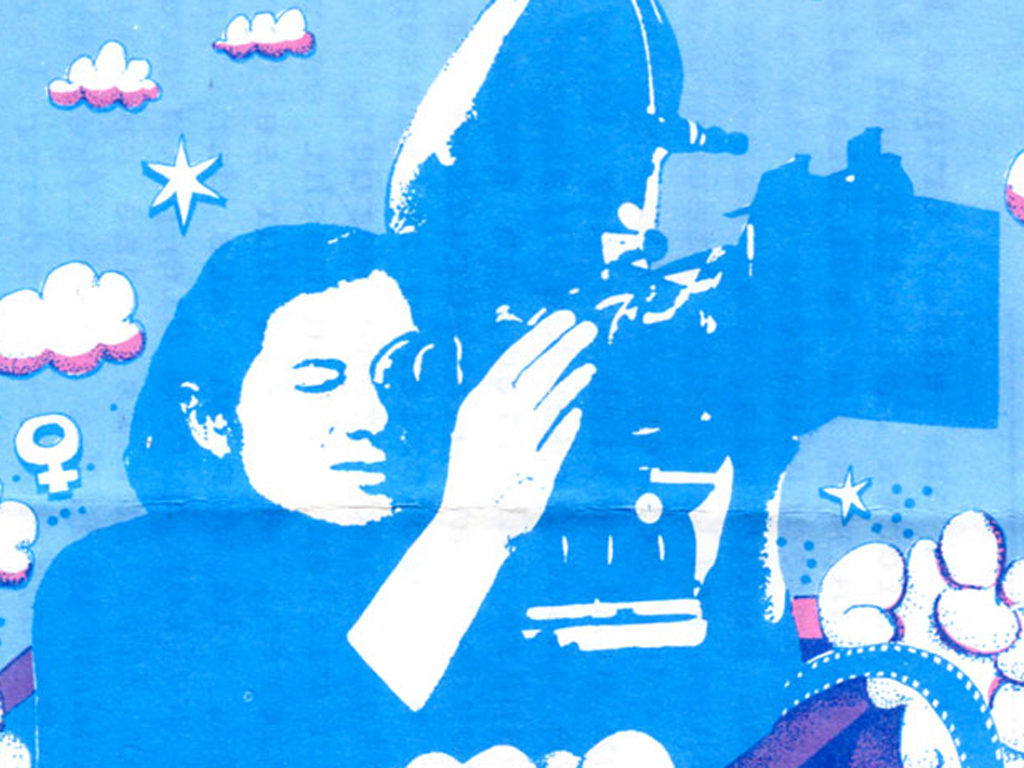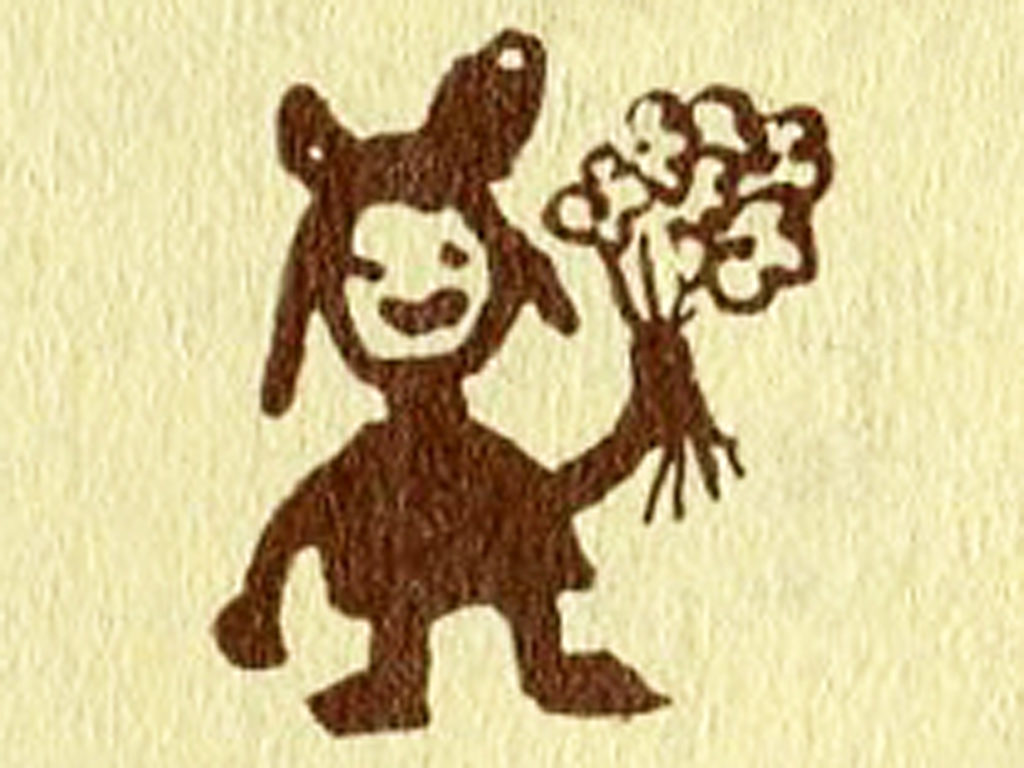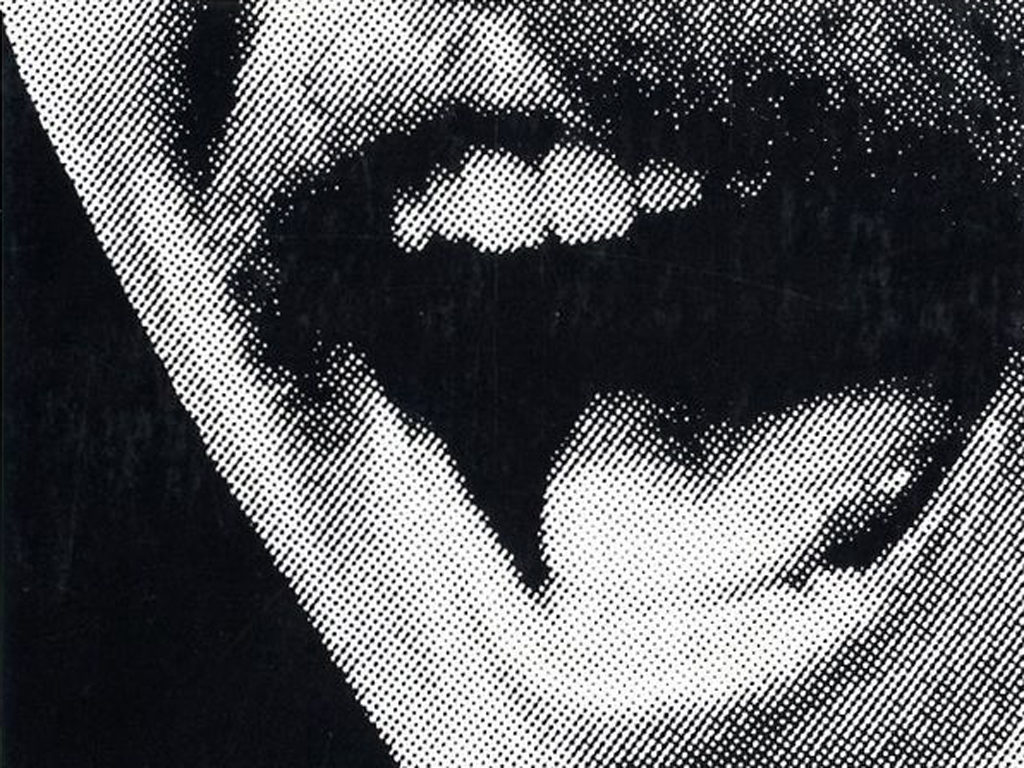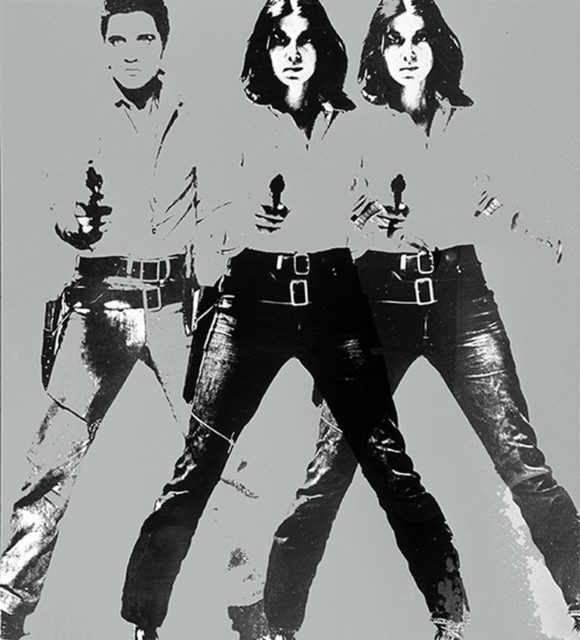
German women were not allowed to study at art academies until 19191. Before that women artists had to go abroad for studying (mainly to Paris), take private lessons (as Gabriele Münter did with Wassily Kandinsky) or founded their own women academies (e.g. in Berlin and Munich). Women in the arts were first and foremost considered as muses up until the 1970s. Traces of women artists, who managed to create art against all odds during the previous centuries, were almost buried in oblivion and had to be uncovered with much effort. This is what feminists did from the middle of the 1970s onwards.
Late 1960s / early 1970s: First Feminist Art Works
The first women artists come up with feminist works of art. They mainly use performance and video art for questioning gender roles by using their own bodies: Linda Benglis with her provocative penis-sculpture in Self (1970), Ulrike Rosenbach with her Presley-citation Art is a criminal Action (1968) or Valie Export with her works Tapp- und Tastkino (1968) or Aktionshose (1969). They are mostly met with incomprehension not only in the art business but often also in the women’s movement.

1971: Feminist Aesthetics
Why Have There Been No Great Women Artists? This question is raised in an essay by the feminist art historian Linda Nochlin in 1971, which still is regarded as the beginning of feminist aesthetics.
1974: The Three Nanas by Niki de Saint Phalle
Three Nanas are installed at the Leibnizufer in Hannover by the French artist Niki de Saint Phalle. Her colourful and monumental female sculptures make her famous in Germany. „With her slogan ‚All power to the Nanas‘ Niki de St. Phalle basically picked up the ideas of the women’s movement.”2
1975: Valie Export’s MAGNA.Feminism
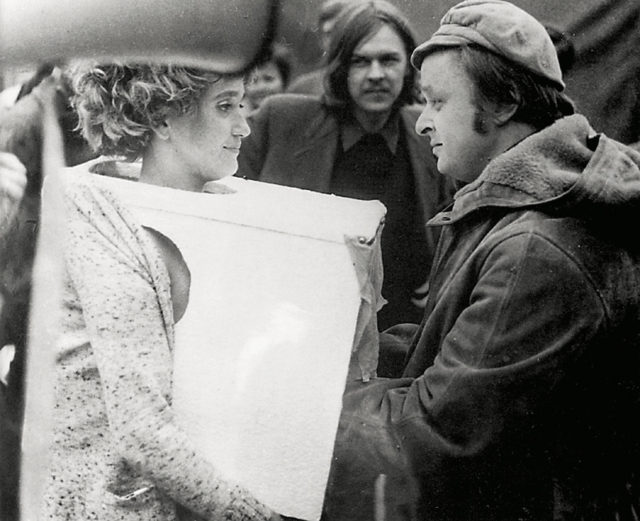
VALIE EXPORT starts developing the exhibition MAGNA.Feminism: Art and Creativity. A Survey of the Female Sensibility, Imagination, Projection and Problems Suggested through a Tableau of Images, Objects, Photographs, Lectures, Discussions, Films, Videos and Actions3, which is exhibited in March and April of 1975 at the Vienna Gallery close to St. Stephan. MAGNA.Feminism differs a lot from the „extremely conservative and stately organised exhibition on the ‚Woman’s Year“ and is a convincing success with 200-250 visitors daily.4
Dezember 1975: Annegret Soltau – Pioneer of Body Art
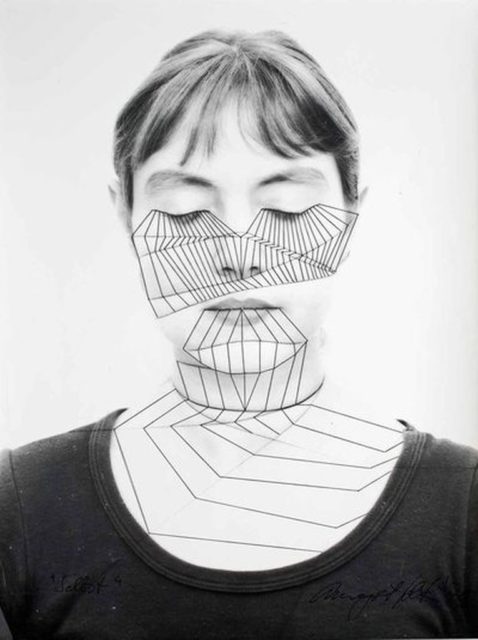
The feminist artist Annegret Soltau becomes a pionieer of body art with her performance Permanente Demonstration in the Galerie Kunstwerkstatt in Darmstadt. In the same year Soltau develops her new method of ‚Fotovernähung‘ – photomontage with needle and thread. The focus of Soltau’s artistic work is put on the constant confrontation with her own self- and body image: „My basic aim is to incorporate bodily processes in my pictures, connecting body and soul equally.“5
1976: Female Artists on the Rise
The advanced reissue of Gisèle Freund’s art sociological PhD-Thesis is published in German translation under the title Photographie und Gesellschaft6. It is regarded as „a milestone in the research on modern visual culture“7. The Franco-German photographer and photo historian is associated member of the Magnum agency and well known for her portraits of famous twentieth century intellectuals (such as Virginia Woolf and Simone de Beauvoir). Since 1968 Freund’s status as professional photo artist is acknowledged with major solo exhibitions. Her popularity in Germany increased since the mid 1970ies – at the latest since documenta 6 (Kassel) in 19778.
Together with Anne Sutherland Harris Linda Nochlin curates the exhibition Women Artists: 1550-1950 in the Los Angeles County Museum of Art. It presents and documents 150 works of 83 partly unknown women artists of four centuries9. The feminist art theorist and curator Lucy R. Lippard publishes an essay in Toronto titled From the center: feminist essays on women’s art10.
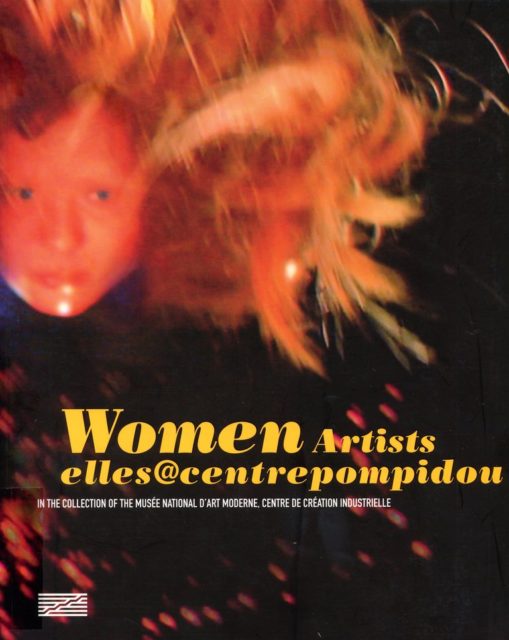
After her return form the US Ulrike Rosenbach founds a School for Creative Feminism in Cologne and starts a call in feminist magazines. A working group starts meeting in spring 1977 and publishes a 50-page catalogue on this “example of autonomous cultural activities” in 198011.
1977: Female Content in the Arts?
The painters Sarah Schumann, Evelyn Kuwertz and five other women of the working group ‚Women in the Fine Arts’ in the West-Berlin art association Neue Gesellschaft für Bildende Kunst (NGBK) present the exhibition Künstlerinnen international: 1877 – 1977 in the Charlottenburg Palace with more than 500 works of 182 women artists, among them Hannah Höch, Meret Oppenheim and Eva Hesse. The curator’s intention is to „examine, if there is such a thing as specifically female content in the arts and whether or not women artists have yet managed to convey this kind of content within male dominated art business.”12
The first edition of Kassandra: Feministische Zeitschrift für die visuellen Künste is published in Berlin.13
1978: The First Women’s Gallery
In Berlin the artist Ebba Sakel opens the first women’s gallery (Galerie Andere Zeichen / Bleibtreustraße) on the 15th of January.14
1979: Künstlerinnen International Exhibit in Berlin
In the exhibition Künstlerinnen International photographs of the British pioneer in photography Julia Margaret Cameron (1815-1879) are on display in Germany. Four years later in March 1979 – exactly one hundred years after the death of the photographer – Julia Margaret Cameron’s portrait named Stella (1867) is sold at Sothebys in London reaching the highest price ever paid for a photograph.15
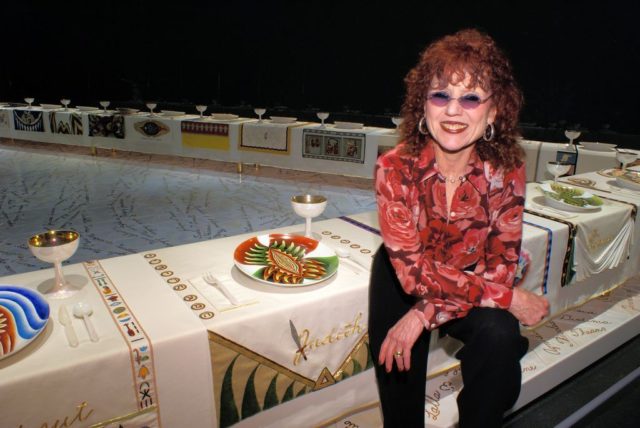
After six years of preparations the San Francisco Museum of Modern Art presents Judy Chicago’s installation Dinner Party for the very first time. The work pays tribute to mythical and historical female figures from ancient history to the twentieth century. There is a place for 39 representatives of women’s history at a triangular table with an individually designed plate made of pottery, of which each is a variation of the vulva-motif. 999 names of famous women are written on porcelain tiles that build the floor of the installation and they stand for the female cultural heritage. Another aspect of Dinner Party is that it also reflects Judy Chicago’s intention to put less prestigious crafts with a female connotation (textile works, pottery and porcelain painting) on the same level as male dominated so-called high art. In 1987 Dinner Party is exhibited in the Kunsthalle Schirn in Frankfurt/Main.16 Since 2007 Dinner Party is on permanent display at the Brooklyn Museum, New York.
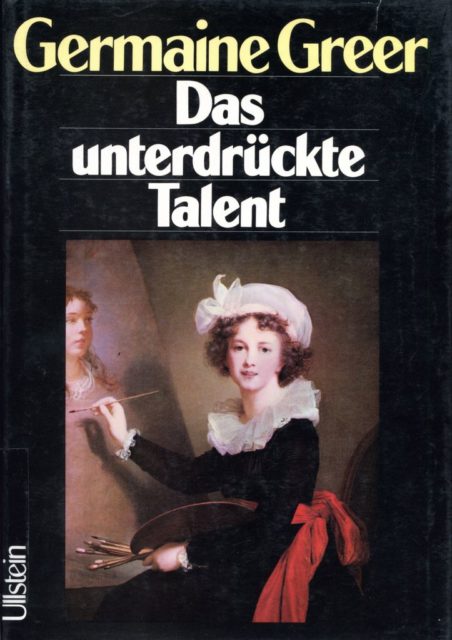
Germaine Greer publishes The Fortunes of Women Painters and Their Work (1979 eng./1980 dt.).17 The study is still considered the standard reference on this topic to the present day (reviewed by Linda Nochlin). The London-based Australian had become the voice of international feminism earlier in 1979 with her bestselling work The Female Eunuch18.
1980: Copenhagen’s International Festival of Women Artists
Parallel to the world conference on occasion of the United Nations Decade for Women, the International Festival of Women Artists takes place in Copenhagen 14-30 July 1980. Women artists from more than 30 countries meet for creative dialogue.19 The painter Maria Lassnig returns from the US to take up a professorship at the University of Applied Arts Vienna. She becomes the first female professor for painting at an academy in the German-language area.
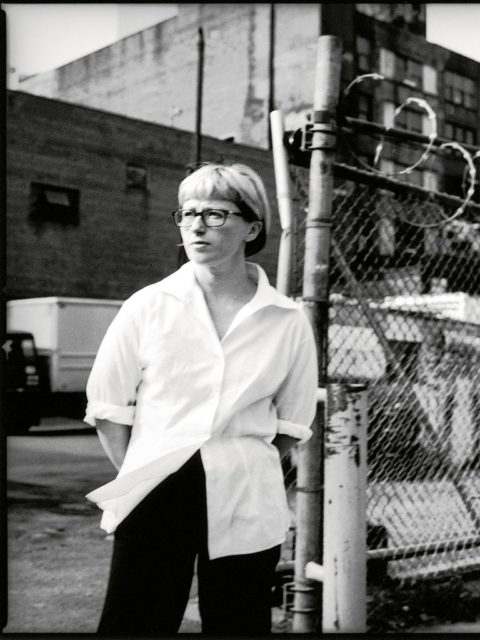
In the early 1980s photo artist Cindy Sherman becomes known internationally. Her method: Embodying female roles of her time, from the well-behaved house-wife to the murdered woman. With her work Sherman increases awareness of the stereotypical view on women’s lives and influences following generations of women artists.
1981: First Women’s Museums
On May 2nd 1981 the worldwide first women’s museum is founded in Bonn. According to Marianne Pitzen, co-founder and director, the goal is „to promote women’s art and make it an essential part of art history”20. The same year the National Museum of Women in the Arts (NMWA) is founded by Wilhelmina Cole Holladay and Wallace F. Holladay in Washington D.C. / USA on the basis of their personal collection. Both women’s museums exist to the current day.
1982: Congress of Feminist Art Historians
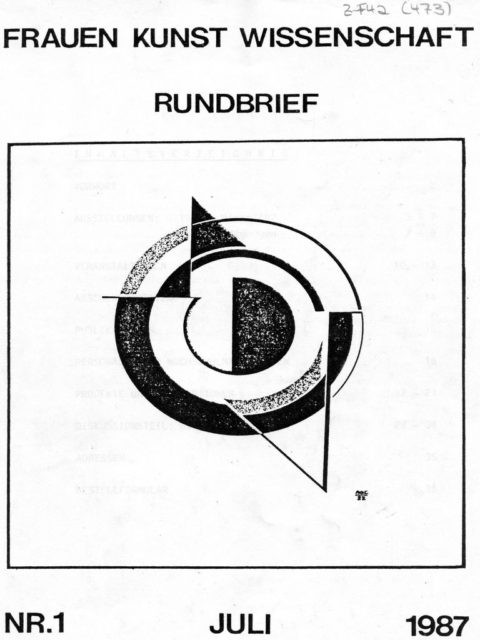
Woman – Art – Society – Critical Scholarship is the title of the first congress of feminist art historians at Marburg University 22-24 October 1982. It initiates feminist art history in the German-speaking region.21
For the very first time in Germany works of the Mexican painter Frida Kahlo and photographs of Tina Modotti are on shown in Berlin, Hannover and Hamburg. Curators of this exhibition are the feminist film theorist Laury Mulvey (widely known since 1975) and her husband Peter Wollen.22
1985: The Guerilla Girls
The Guerilla Girls, an New York based group of anonymous feminist activist artists wearing gorilla masks, become active.
They fight with posters, stickers and performances against the discrimination of women and minorities in the art business using subversive humour. The Guerilla Girls see themselves as feminist consciousness in the world of art.23
1986: A Question of Visability
![Das Verborgene Museum, Bd. 1: Dokumentation der Kunst von Frauen in Berliner öffentlichen Sammlungen. - Neue Gesellschaft für Bildende Kunst (NGBK) [Hrsg.]. Berlin : Ed. Hentrich. (FMT-Signatur: KU.17.377-Bd.1) Das Verborgene Museum, Bd. 1: Dokumentation der Kunst von Frauen in Berliner öffentlichen Sammlungen. - Neue Gesellschaft für Bildende Kunst (NGBK) [Hrsg.]. Berlin : Ed. Hentrich. (FMT-Signatur: KU.17.377-Bd.1)](http://frauenmediaturm.de/wp-content/uploads/2018/07/Das_verborgene_Museum-453x640.jpg)
1987: Frauen Kunst Wissenschaft
After the 3. congress of feminist art historians in Vienna 1986, the first edition of Frauen Kunst Wissenschaft is published as a circular. Its main topic is Judy Chicago‘s exhibition Dinner Party. 2007 the title is changed into FKW -Zeitschrift für Geschlechterforschung und visuelle Kultur. 54 editions are publishd in print. Since 2014 FKW is available as digital magazine only.
Manfred Schneckenburger, artistic director of the international art exhibition documenta 8 in Kassel, justifies the proportion of his choice of 317 male to 36 women artists (11 %)25 by arguing that the overall percentage of women in the art business is only 8 %. Women are obviously not allowed to gain more space in the arts during the 1980s.26
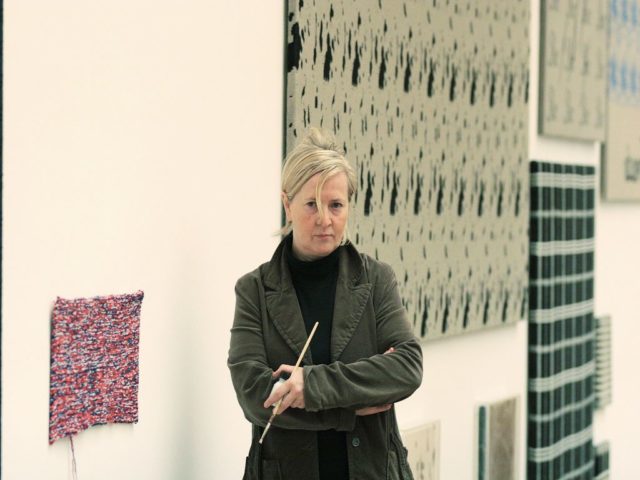
What happens next?
During the 1990s the percentage of German women artists (e.g. Rosemarie Trockel or Rebecca Horn) standing their ground on the international art market starts increasing. At the same time more women become art managers in galleries and museums. In 1993 53 % of all art students are female.27
In 1990 the political concept artist Jenny Holzer (USA) becomes the first woman ever to represent her country in a solo exhibition at the Biennale di Venezia. She is also awarded the Golden Lion for the best pavilion.28 In the same year the Frankfurter Kunstverein shows the first European retrospective of the Franco-American artist Louise Bourgeois, whose art focuses on the topic of sexual violence. It is quite striking, how often contemporary female artists pick out sexual violence and abuse during childhood as central theme (from Niki de St. Phalle to Anette Messager).
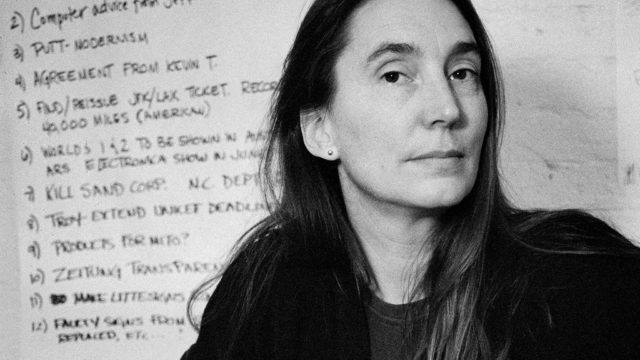
In 1994 Gudrun Wassermann and Thea Richter become the first awardees of the Gabriele-Münter-Prize, which they are given by Angela Merkel (in her function as Federal Minister of Women’s Affairs). The intention of the award – which is named after the long-time partner of Kandinski and underestimated pioneer of Modern art – is to promote women artists over the age of forty. The financial support should make up for „the many years that creative work is cut back due to the upbringing of children and caring for the family”.29 The initiators of the award are the Federal Association of Visual Artists e.V., GEDOK – Association of the Communities of Artists and Patrons e.V., the Women’s Museum Bonn and the Federal Ministry for Women.30
WACK! Art and the Feminist Revolution in the Museum of Contemporary Art in Los Angeles is 2007 the first exhibition, which looks back on feminist inspired art between 1965 and 1980 and presents the work of 120 international women artists.3
On May 27, 2009, the exhibition elles@centrepompidou opens at the Centre Pompidou in Paris.32 For two years, the museum presents 350 works by 150 women artists of the 20th and 21st centuries. Responsible for the new presentation of the permanent collection at the Centre Pompidou is the curator Camille Morineau, according to which an „overview of the twentieth century from the perspective of women artists turns out to be more extreme, more radical, more violent in performance“.33
In 2010 the Historische Museum Frankfurt honours the life’s work of a great photographer of the post-war generation in Germany with the exhibition Abisag Tüllmann (1935-1996) photo essays and theatre photography. Tüllmann was – like her colleague Angela Neuke-Wiedmann in Munich – chronicler of the New Women’s Movement. With her social documentaries34, Tüllmann accompanied the actions against Paragraph 218, gave insights into Frankfurt women’s projects, documented women’s congresses and seminars.35
The Sammlung Verbund in Vienna exhibits more than 150 works by feminist artists in 2015.36 Curator Gabriele Schor coined the term feminist avant-garde, whose merit lies in the transformation of the women artist’s image from the object of the male gaze to a sovereign subject.37
![Frauen die forschen : 25 Porträts von Bettina Flitner (2008). - Rubner, Jeanne [Hrsg.] ; Flitner, Bettina [Ill.]. München : Heyne (FMT-Signatur: BI.12.055) Frauen die forschen : 25 Porträts von Bettina Flitner (2008). - Rubner, Jeanne [Hrsg.] ; Flitner, Bettina [Ill.]. München : Heyne (FMT-Signatur: BI.12.055)](http://frauenmediaturm.de/wp-content/uploads/2018/07/Frauen_die_-forschen-504x640.jpg)
The visual archive of the FrauenMediaTurm is intended to secure the multifaceted image of women and women’s history and to sharpen the eye for a manipulative misogynist treatment of images. FMTvisuell is, to our knowledge, the first and only feminist picture archive so far under this aspect.
References
1 Weimarer Constitution of 01.08.1919 § 109: " Men and women have in principle the same civil rights and duties.". Art academies in Berlin und Dresden were the first to grant women admission. See: Herber, Ann-Kathrin (2009): Frauen an deutschen Kunstakademien im 20. Jahrhundert: Ausbildungsmöglichkeiten für Künstlerinnen ab 1919 unter besonderer Berücksichtigung der süddeutschen Kunstakademien ; Dissertation Universität Heidelberg. - Deutsche Nationalbibliothek: http://d-nb.info/1007430338/34
2 Rochner, Renate: Niki de Saint Phalle. - See: FemBio. Frauen.Biographieforschung: http://www.fembio.org/biographie.php/frau/biographie/niki-de-saint-phalle/
3 This is the title of the 1977 group exhibition, based on the concept which was begun in 1972.
4 Gerhardt, Renate ; Kuwertz, Evelyn ; Schuhmann, Sarah (1975): Weibliche Inhalte auf weibliche Weise darstellen. Frauenspezifisches in der Kunst, am Beispiel von sechs Künstlerinnen. - In: Magazin Kunst, Nr. 4, S.76 (FMT-Shelf Mark: KU.17.-a, Obj.Nr. 8870).
5 Citation of Annegret Soltau: Statements. - See: www.annegret-soltau.de/de/pages/statements
6 The German translation of the first edition was published as early as 1968 in Munich under the title: Photographie und bourgeois Gesellschaft. (French title: La Photographie en France au dix-neuvième siècle, Paris, 1936). In 1974 a completely revised and expanded version appeared in Paris: Photographie et société, which was then finally published in 1976 in Munich in German translation.
7 Gisèle Freund. - See: www.fembio.org/biographie.php/frau/biographie/gisele-freund/
8 See Wittlich, Angelika (1977): „Aus Ihnen wird nie etwas!“ - In: EMMA, Nr. 9, S. 52-58. www.emma.de/lesesaal/45140
9 Harris, Ann Sutherland ; Nochlin, Linda (1978): Women artists: 1550-1950. - Los Angeles, Calif.[u.a.] : Los Angeles County Museum of Art [u.a.] (FMT-Shelf Mark: KU.17.380)
10 Lippard, Lucy R.(1976): From the center: feminist essays on women's art. - Toronto [u.a.] (FMT-Shelf Mark: KU.17.133)
11 Kreativer Feminismus (1980). - In: EMMA, Nr. 12, S. 56f.. www.emma.de/lesesaal/45179
12 Gerhardt, Renate ; Kuwertz, Evelyn ; Schuhmann, Sarah (1975): Weibliche Inhalte auf weibliche Weise darstellen. - In: Magazin Kunst, Nr. 4, S.76 (FMT-Shelf Mark KU.17.-a / Obj.Nr. 8870).
13 Kassandra : Feministische Zeitschrift für die visuellen Künste. Oellerich, Monika [Hrsg.] ; Corradini, Bigina [Hrsg.] ; Dech, Jula [Hrsg.]. - Berlin: Kassandra-Verl., 1977. (FMT-Shelf Mark: Z-F007, two issues)
14 Nachrichten aus der Frauenbewegung : Es gibt endlich eine Frauengalerie (1978). - In: Courage, Nr. 1, S. 55. : library.fes.de/courage/pdf/1978_01.pdf
15 Strobl, Ingrid (1979): Julia Margaret Cameron : die Pionierin mit der Camera. - In: EMMA, Nr. 8, S.54-58. www.emma.de/lesesaal/45163
16 Judy Chicago, The Dinner Party : Schirn Kunsthalle Frankfurt, 1. Mai - 21. Juni 1987. Kunsthalle
17 Greer, Germaine (1980): Das unterdrückte Talent : die Rolle der Frauen in der bildenden Kunst. – Berlin (u.a.): Fischer (FMT-Shelf Mark KU.17.NA.008) bzw. Greer, Germaine (1979): The obstacle race : the fortunes of women painters and their work. - New York: Farrar, Straus and Giroux.
18 Greer, Germaine (1971): Der weibliche Eunuch : Aufruf zur Befreiung der Frau. - Frankfurt am Main : Fischer (FMT-Shelf Mark FE.10.013-1971[02]).
19 The documentation can be found at the archive of the National Museum of Women in the Arts (Washington D.C.). The international festival of women artists, 1980. - See: National museum of women in the arts: https://nmwa.org/sites/default/files/shared/4.3.4.2-international_festival_of_women_artist_collection.pdf [PDF-document]
20 Über uns. Zielsetzung. - See: Frauenmuseum Bonn: https://www.frauenmuseum.de/museum/uber-uns/haus/
21 Frauenkunstgeschichte : zur Korrektur des herrschenden Blicks (1985). - Bischoff, Cordula [Hrsg.] : Dinger, Brigitte [Hrsg.] ; Ewinkel, Irene [Hrsg.] ; Merle, Ulla [Hrsg.]. Gießen : Anabas-Verlag (FMT-Shelf Mark: KU.17.159).
22 Frida Kahlo und Tina Modotti (1982). - Francis, Mark [Hrsg.]. Frankfurt am Main : Verlag Neue Kritik.
23 On their posters the Guerilla Girls call themselves the „conscience of the art world“. An overview of their work can be found on the Guerilla Girl-Website: https://www.guerrillagirls.com/projects/
24 See: Das Museum. - See: Das Verborgene Museum: http://www.dasverborgenemuseum.de/das-museum
25 See documenta archive – Statistiken. Anteil der Künstlerinnen (2014). - Verfügbar unter: documenta Archiv für die Kunst des 20. Und 21. Jahrhunderts [Bibliotheksdatenbank des documenta Archives, 05.03.2014]: http://feuerwehr.stadt-kassel.de/imperia/md/images/cms04-miniwebs/documenta-archiv/documenta_ausstellungen_-_k__nstlerinnen_d1-d13.pdf [PDF-document]
26 Eromäki, Aulikki ; Herter, Renate ; Wagner-Kantuser (1989): Zur Situation von Frauen im Kunstbetrieb : Dokumentation eines Seminar- und Forschungsprojektes 1983-1989. - Berlin : HdK, S. 9 (FMT-Shelf Mark KU.17.387).
27 Olaf Zimmermann: Wie brotlos ist die Kunst. - See: Konrad Adenauer Stiftung: http://www.kas.de/upload/dokumente/frau/9803zimmermann.pdf [PDF-document]
28 Chadwick, Whitney: Frauen, Kunst und Gesellschaft (2013). - Berlin [u.a.] : Deutscher Kunstverlag, S. 496 (FMT-Shelf Mark KU.17.536).
29 Merkel, Angela (2011): Grußwort zur 1. Vergabe des GABRIELE MÜNTER PREISES 1994. - Verfügbar unter: Dokumentation Gabriele Münter Preis, Frauenmuseum Bonn (Hrsg), Bonn, S.7: http://gabrielemuenterpreis.de/wp-content/uploads/muenter-doku_web.pdf [PDF-document]
30 Today the name of the Ministry is: Bundesministerium für Familie, Senioren, Frauen und Jugend
31 Wack! : art and the feminist revolution ; [catalogue accompanying an exhibition held at the Museum of Contemporary Art, Los Angeles, Mar. 4 - July 16, 2007 and at the National Museum of Women in the Arts, Washington, D.C., Sep. 21 - Dec. 16, 2007] (2007). - Museum of Contemporary Art Los Angeles [Hrsg.]. Cambridge, Mass : MIT Press (FMT-Shelf Mark KU.17.036).
32 Elles at Centre Pompidou : women artists in the collection of the Musée National d'Art Moderne, Centre de Création Industrielle ; [published to coincide with the exhibition-collection "Elles at Centrepompidou. Women artists in the Collection of the Musée National d'Art Moderne, Centre de Création Industrielle", presented at the Centre Pompidou, Paris, from 27 may 2009] (2009). - Musée National d'Art Moderne Paris [Hrsg.] ; Centre de Création Industrielle Paris [Hrsg.] ; Centre National d'Art et de Culture Georges Pompidou Paris [Hrsg.]. Paris : Éd. du Centre Pompidou (FMT-Shelf Mark KU.17.511).
33 Schwerfel, Heinz Peter (2009) : Künstlerinnen unter sich, 26.05.2009. - In: art - das kunstmagazin.
34 This is how Tüllmann describes her picture-journalistic work herself. Source: see footnote 22.
35 The filmmaker Claudia von Alemann dedicates a cinematic homage to her longtime girlfriend and companion in 2015: Alemann, Claudia von (2015): Die Frau mit der Kamera : Porträt der Fotografin Abisag Tüllmann. [92 Minuten, Deutschland]. See: https://www.filmportal.de/en/movie/die-frau-mit-der-kamera-portrat-der-fotografin-abisag-tullmann_
36 Feministische Avantgarde der 1970er Jahre : Werke aus der SAMMLUNG VERBUND, Wien (2015). - Schor, Gabriele [Hrsg.]. München (u.a.) : Prestel (FMT-Shelf Mark KU.01.172).
37 Schor, Gabriele (2016): Die Feministische Avantgarde. - In: EMMA, Nr. 6, S. 58 - 68. www.emma.de/lesesaal/61385
38 See: FMTvisuell mit 8.000 Bildern online. - FrauenMediaTurm. Das Archiv und Dokumentationszentrum: http://www.frauenmediaturm.de/recherche/bilddatenbank/
39 Frauen die forschen : 25 Porträts von Bettina Flitner (2008). - Rubner, Jeanne [Hrsg.]. München : Heyne. (FMT-Shelf Mark: BI.12.055)
Date of the last linkcheck: 30.01.2018
Selective Bibliography
Documents online
Julia Voss (2013): Die moderne Kunst ist ein alter Herrenclub. In: EMMA, Heft 2, 2013, S.82-85.
Recommendations
Renate Gerhardt, Evelyn Kuwertz, Sarah Schumann (1975): Weibliche Inhalte auf weibliche Weise darstellen. Dokumentation: Frauenkunst ; Frauenspezifisches in der Kunst am Beispiel von sechs Künstlerinnen. In: Magazin Kunst, 15. Jg., Nr. 4/1975, S. 76-86. (FMT-Signatur: KU.17-a / Obj. Nr. 8870)
Germaine Greer (1980): Das unterdrückte Talent : die Rolle der Frauen in der bildenden Kunst. - Berlin: Ullstein. (FMT-Signatur: KU.17.NA.008)
Anja Zimmermann [Hrsg.] (2006): Kunstgeschichte und Gender : eine Einführung. - Berlin: Reimer. (FMT-Signatur: KU.17.NA.005)
Gabriele Schor [Hrsg.] (2015): Feministische Avantgarde : Kunst der 1970er-Jahre aus der Sammlung Verbund, Wien. - München: Prestel. (FMT-Signatur: KU.01.172)
Whitney Chadwick (2013): Frauen, Kunst und Gesellschaft. – Berlin u.a.: Deutscher Kunstverlag. (FMT-Signatur: KU.17.536)
FMT Press Documentation
Press Documentation on Art & Photography: PDF-Download
The FMT press documentation is thematically structured and indexed. It comprises articles of the general public press, feminist press and other documents, such as leaflets and archival documents.
Selected FMT-Sources (lists)
Catalogues of Important Exhibitions: PDF-Download
Related Topics
Female Filmmakers
Female Filmmakers
Many young female filmmakers are active in the Women's Liberation Movement, addressing feminist issues in a variety of film genres. › mehr
Female Makers: Pioneering Feminist Projects in Germany
Female Makers: Pioneering Feminist Projects in Germany
"We claim for an all-women room!" That was the slogan of the autonomous women's projects founded in the beginning of the 1970s. › mehr
Feminist Linguistics and Gender Neutral Language in Germany
Feminist Linguistics and Gender Neutral Language in Germany
Before the 1970ies women were practically invisible in the german language. If one man was part of a given group, the male form was used - and the women vanished . Feminist linguistics changed that for good. › mehr



